BMW X7 M60i review: BMW’s biggest gets mild-hybrid power and a face for radio
A face for radio
Just three years after BMW introduced the X7, its biggest and boldest SUV yet, it comes in for a midlife update to keep it in line with the new 7 Series. A redesigned front end was arguably all that was needed to do that, but BMW has taken the opportunity to do a lot more besides, overhauling the X7’s technology suite and adding mild-hybrid power to the refreshed range of engines.
There’s no electric or even plug-in hybrid variant in the pipeline, though, as the model is optimised for its most important markets, namely the US and China. Thanks to the X7’s considerable success in those territories, and the profitability that comes with high-end cars, the M Performance version of the X7 remains in place, albeit with considerable enhancements. It even gets a new badge – M60i – though it’s not the full-on M car some will expect it to be.
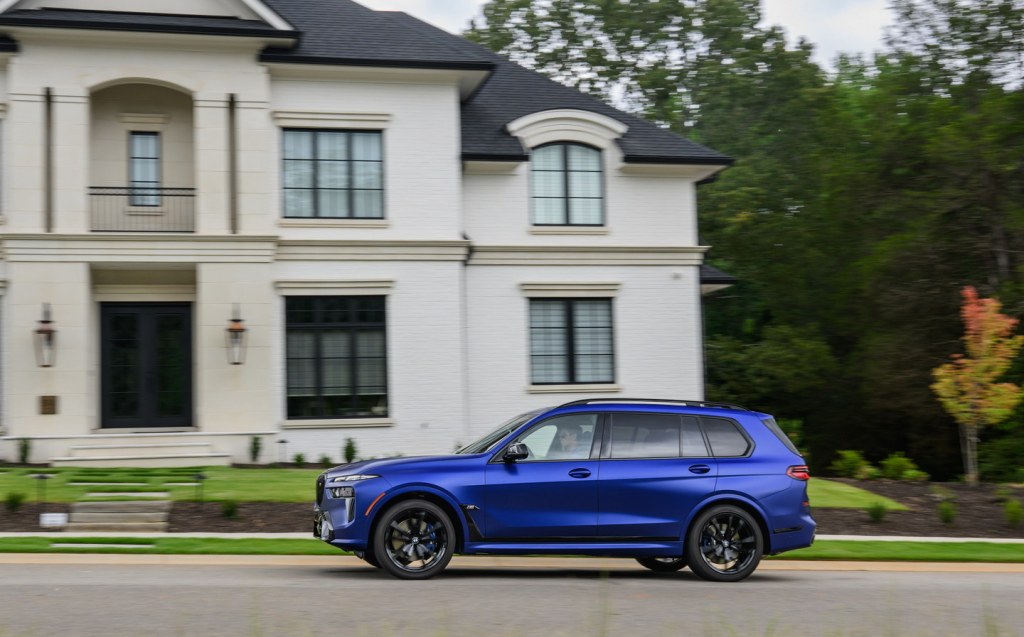
Exterior design and rivals
The usual mid-life facelift tweaks have been applied to the X7, including slightly restyled rear lights, a handful of new colours and a factory-fit option of 23-inch alloy wheels for the first time in a BMW. However, the big talking point is the X7’s new nose, shared with the forthcoming 7 Series – and indeed, the controversial XM SUV.
BMW has restyled the kidney grille a little, and its detailing varies from model to model, but the X7 started life with a large grille anyway, so that’s unlikely to grab any headlines. Illumination of the grille is new, though, borrowed from the BMW X6 and standard across the line-up here. As if the thing needed drawing attention to.
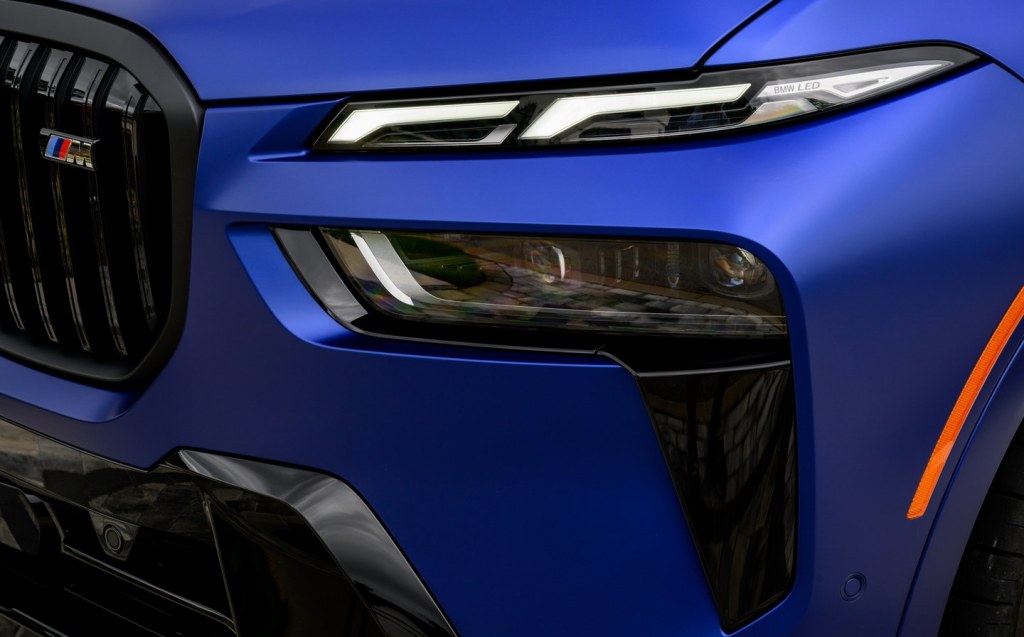
Either side of that are the new lights in an unusual split-level arrangement. Up top there’s a slender LED light unit operating as the daytime running lights and side indicators. The LED elements vaguely allude to the double-circle BMW lights of yesteryear. Further down, separated from the upper lights by a chunk of bodywork, are the main headlights, featuring adaptive matrix LED technology. Meanwhile, the aerodynamic ‘air curtain’ feature that channels air in ahead of the wheels is tightly integrated with the new headlight layout.
The end result is eye-catching for sure, if not universally appealing. Although it’s colour-sensitive, it better suits the tall proportions of the X7 than it does the new 7 Series saloon. There’s a stark difference in appearance between the entry-level Excellence model and the sportier looking M Sport car, the latter eschewing the former’s lashings of chrome. The M60i variant tested here goes further again with a broody black theme of accents, extending to the four exhaust outlets, special door mirrors and the restyled grille.
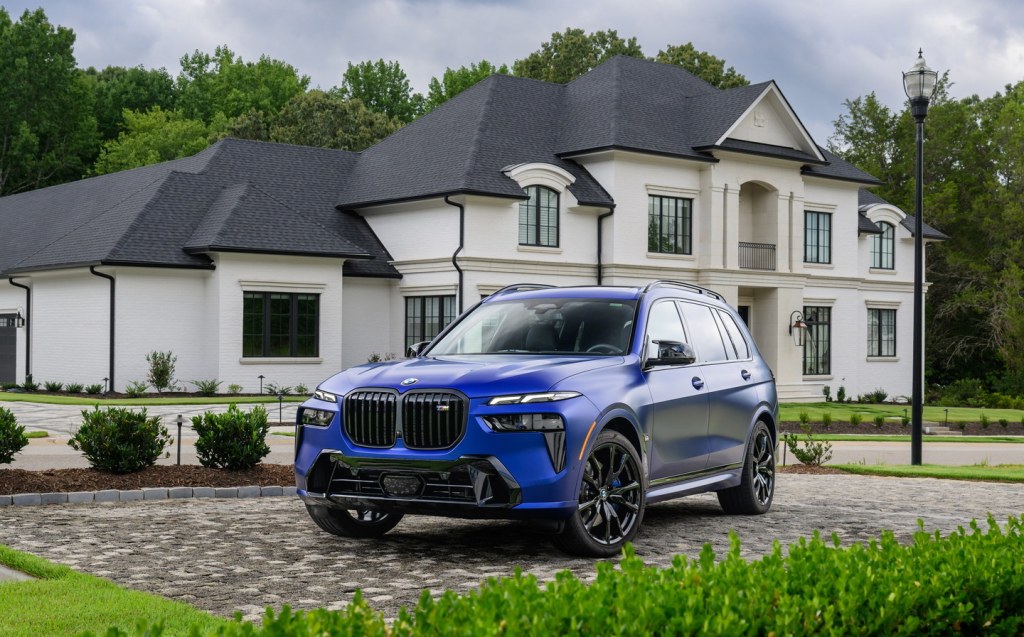
In terms of rivals, the X7 has only a few really obvious direct adversaries. The Range Rover is closest in concept, and is available with a much wider range of powertrains, but it’s more expensive than the BMW when comparing like-for-like models. The Audi Q7 is smaller and less luxurious, despite its seven-seat layout, though the Mercedes GLS is a worthy alternative.
Interior and practicality
As before, the X7 is a full seven-seater by default. There are copious amounts of space in the front two rows and adults can comfortably fit in any of the seven seats. Fill all the seats and there’s only 326 litres of boot space behind, though it’s cavernous with the rear-most chairs folded out of the way. All seats adjust electrically and come with their own air conditioning controls and access to the rear seating is through notably wide rear doors.
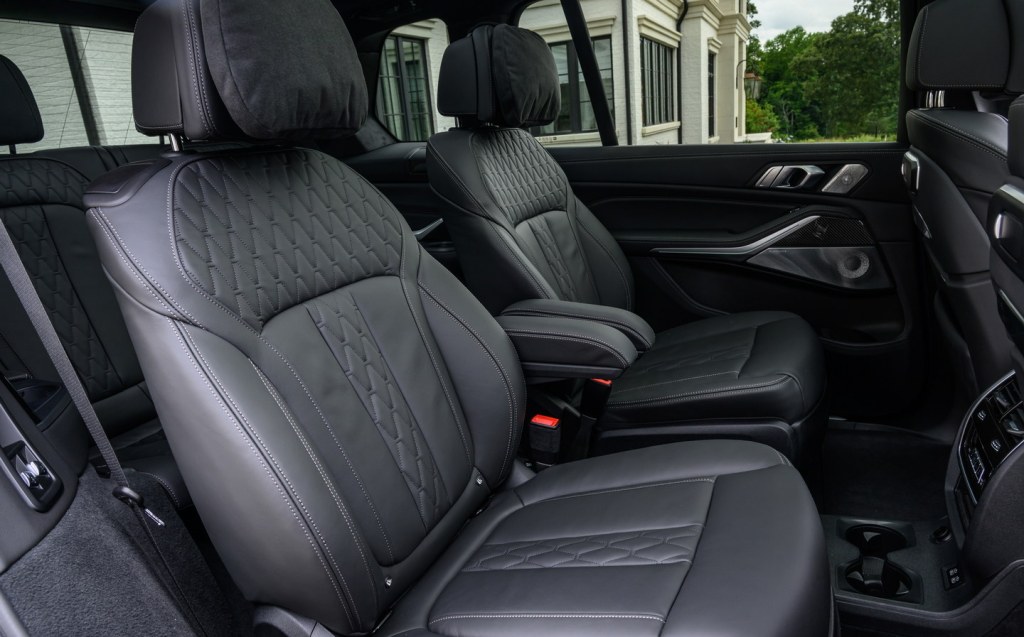
Buyers can swap the middle row of three for two individual chairs, which ups the luxury feel further, and there’s a range of different upholstery and trim options. Leather features heavily, of course, but buyers can choose to replace that by a synthetic material instead, similar in look and feel to genuine leather. That applies to the dashboard as well as the seating and door panels.
There are loads of oddments storage areas and large cupholders (with heating and cooling capability) and the updated X7 features a restyled centre console up front with a more compact drive selector.
Technology and safety
New to the X7 is BMW’s curved dashboard display, as debuted on the i4 and iX. Here it features a 12.3-inch screen to house the digital instrumentation along with a 14.9-inch touchscreen. It runs the latest BMW Operating System 8.0 software, which means a wealth of functionality and connectivity features. It’s not as intuitive to use as older BMW infotainment systems, but owners will soon get to grips with it. Voice control helps with finding some of the more obscure sub-menus and, thankfully, the rotary iDrive controller on the centre console has been retained.

Cleverly, that is used as part of the new Trailer Assistant feature, packaged with the Parking Assistant Pro system. Once activated, this makes reversing and parking with a trailer a cinch. The rear view is displayed on the central screen and to manoeuvre, the iDrive rotary is used on its own, as if it’s the trailer itself that’s being steered. The driver doesn’t touch the car’s steering wheel, as that’s under the system’s control; they just work the accelerator and brake and steer the trailer into position. Pull the rotary dial backwards and that initiates straight-back reversing, with minute control of the car’s steering automatically taken care of. It’s particularly impressive when there’s a tiny trailer hooked up, as only slight changes in steering angle can put the trailer off course. Not that we expect many X7 buyers to use small trailers for anything.
Performance, power output and acceleration
There are three different powertrains offered in the X7. All feature four-wheel drive and a new generation of the ZF-supplied eight-speed automatic transmission. Incongruously, this has launch control built in. More appropriately, it also now houses an electric motor. This is part of the new 48-volt mild-hybrid system that is fitted to all X7s. The motor can add a modest 12bhp and just under 15lb ft of torque, which seems insignificant next to the outputs of the engines available, but it’s used to enhance response to initial accelerator application and to fill in any gaps in the engine delivery.
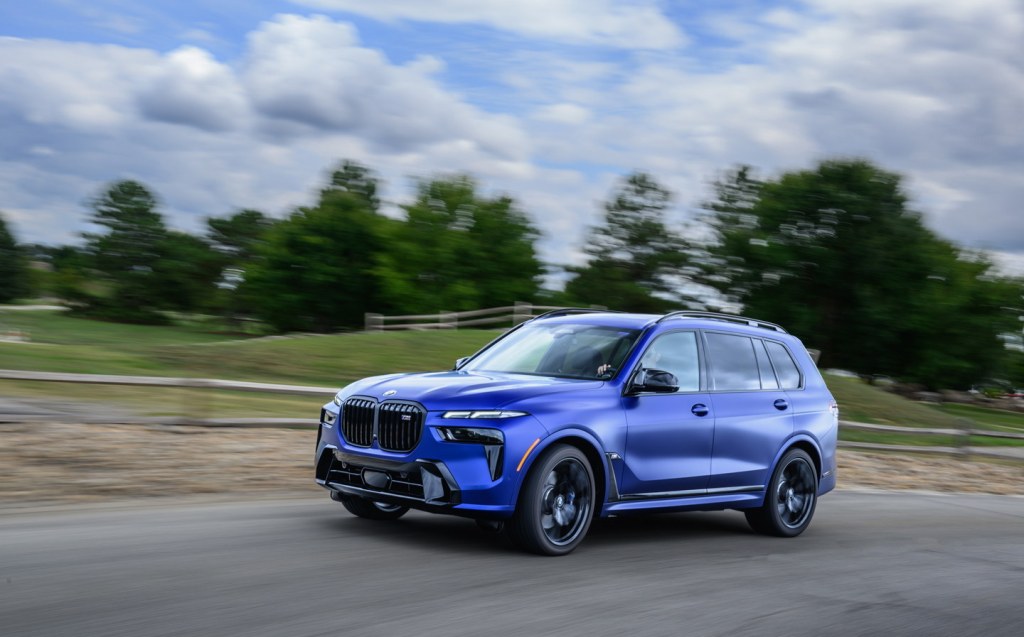
To date, sales of the diesel model have considerably outstripped those of the petrol models and so the xDrive40d variant remains. Indeed, while many car makers are reducing their commitment to diesel power, BMW has further developed the twin-turbocharged 3.0-litre unit, more in the name of efficiency and cleanliness than outright performance. Not that there’s much wrong with its 335bhp and 516lb ft of torque, resulting in a 0-62mph time of just 5.9 seconds. With all that on tap, it should make light work of the maximum 3,500kg towing weight.
Next up is the xDrive40i. This is the biggest-selling model in a global context, so BMW has invested in considerable updates. The turbocharged 3.0-litre petrol engine is more efficient and more powerful than before, managing 0-62mph in 5.8 seconds thanks to peak outputs of 375bhp and 383lb ft of torque. It’s also the only X7 that can move under purely electric power, albeit for short distances at really low speed. We didn’t detect that happening in our time with the car.
If you don’t plan to tow big loads, and you don’t spend long days on the motorway, the petrol model is worth a look. It’s incredibly smooth, much quieter than the diesel and fast by any measure. When you put your foot down, it also sounds superb, as only a straight-six petrol engine can.
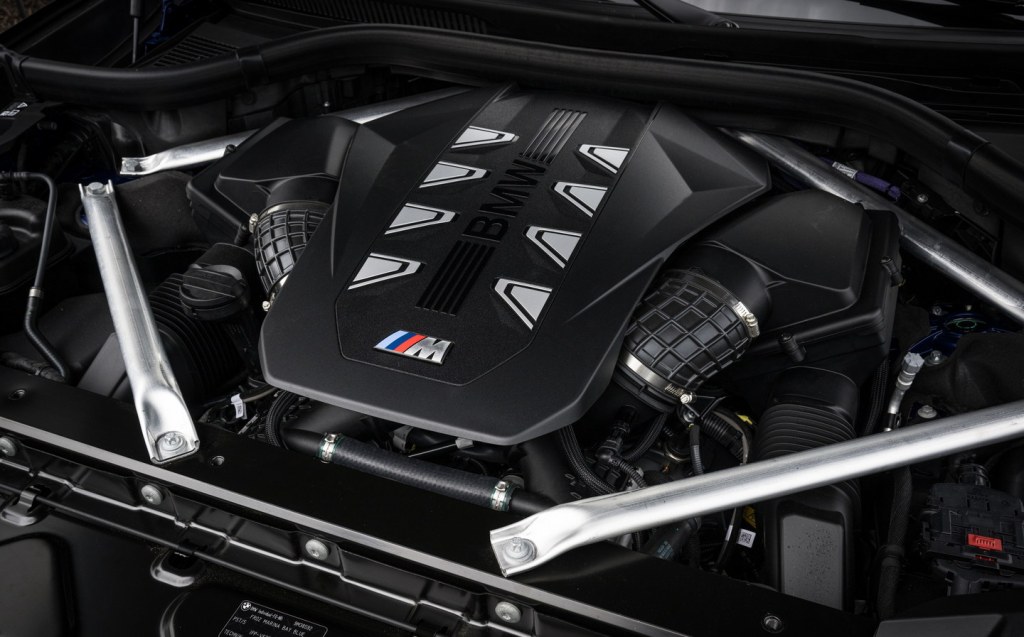
Topping the line-up is the M60i. This is powered by a new twin-turbocharged 4.4-litre V8 engine, developed in collaboration with BMW M. Its peak outputs of 522bhp and 553lb ft are identical to those of its predecessor in the X7 M50i, but the new engine is lighter, more efficient and designed to cope with forthcoming emissions constraints. The mild-hybrid system enhances it, theoretically, though with so much grunt and a serious V8 sound emanating from the exhaust, you’ll be hard pushed to notice its effect. That exhaust is worth a quick mention, though, as it features the first fully-variable flap system in a BMW. Usually there’s a set of bypass valves that are either open or closed to alter the sound; the M60i’s system can be altered between fully open and fully closed depending on a wide variety of parameters, and it sounds sensational when you put your foot down.
Ride and handling
All versions of the X7 ride on self-levelling air suspension, paired with adaptive damping. The settings of the latter system can be altered depending on driving modes, but the default state for the X7 is best described as controlled comfort. It absorbs bumps and surface irregularities with aplomb, isolating passengers from the road surface imperfections and from the noises that come with them. However, the X7 doesn’t float along vaguely in a bid for that comfort; no, despite the considerable weight of the car, its body’s motions are kept firmly in check, impressively so in the corners. The only time you really get a sense that the chassis is working hard is under heavy braking, but even so, the X7 is supremely stable.
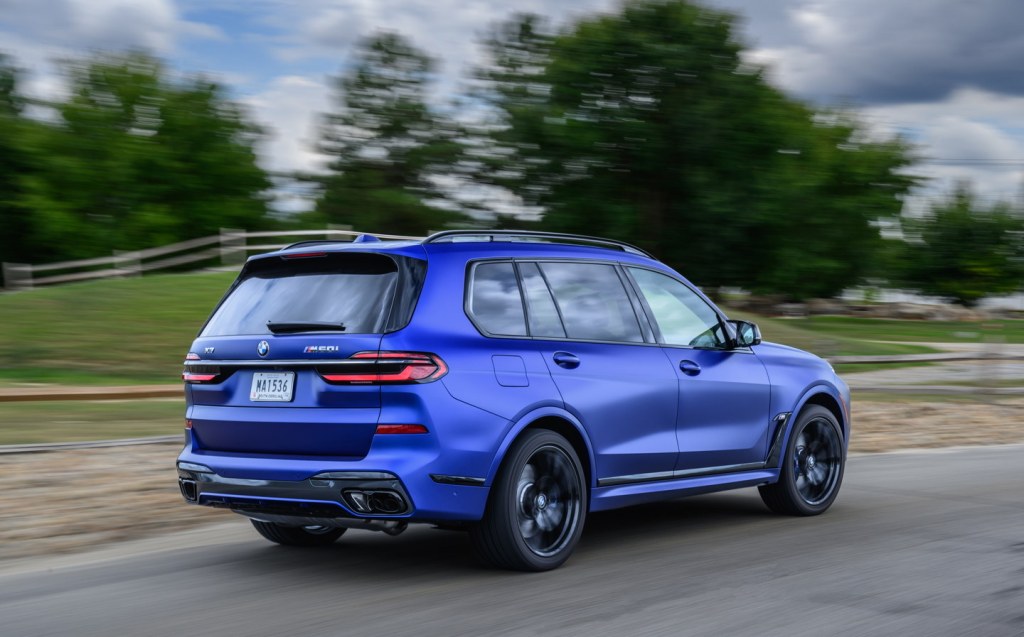
Is it fun to drive? Not in the way a BMW sports saloon is, no, but it’s more engaging that most huge SUVs of its ilk. The steering is well-judged and in fact, the M60i gets BMW’s ‘Integral Active Steering’ system to steer the rear wheels. This makes the car feel shorter and more agile at low speeds – and when manoeuvring – while enhancing stability at higher speeds, as when changing lane, for example. It’s never obviously at work, but the X7 M60i feels nimbler than it should through a sequence of interesting corners.
Saying that, while the steering is well-weighted – and that’s adjustable in the driving settings, too – there’s precious little real feedback coming up through the system to the driver’s hands. In short, the M badge on the tailgate means that this car is fast and competent, but don’t expect to want to take it for a pre-dawn blast on an autumn morning for the sake of it. It’s a luxury car at heart, but one that can hold its own in the bends.
Avoid the 23-inch wheels unless you only use billiard table-smooth roads. The M60i on 22-inch rims rides perfectly well, though.
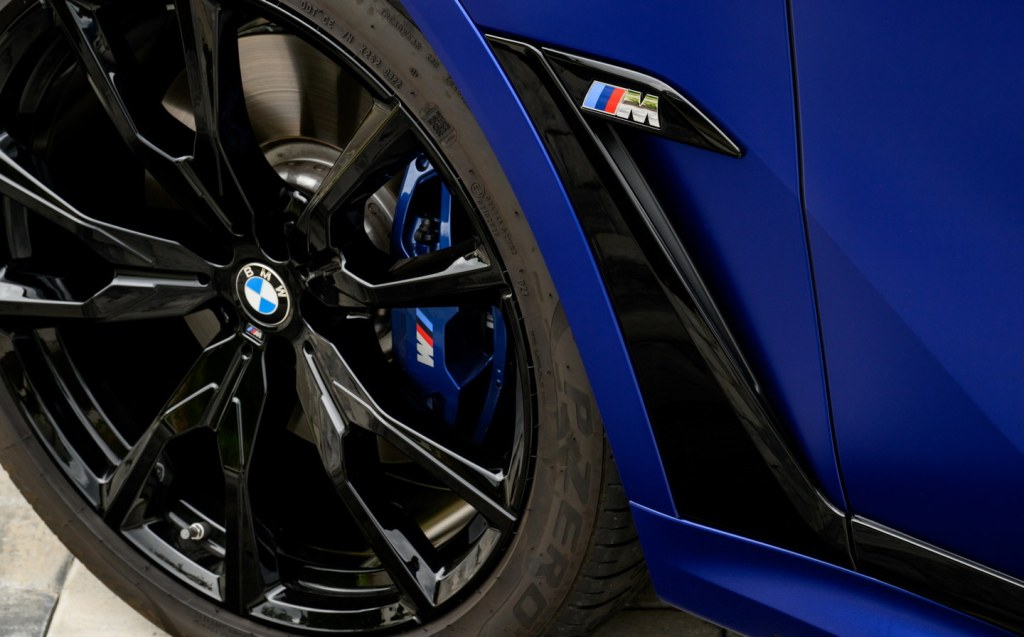
Pricing and on-sale date
The updated X7 is available to order in the UK now. The most popular model to date has been the xDrive40d and that starts at £80,980 in Excellence guise. Meanwhile, the xDrive40i is priced from £81,600. The M Sport variant is £3,000 extra in both cases. The M60i tested here starts at £103,600.
Verdict: BMW X7 M60i review
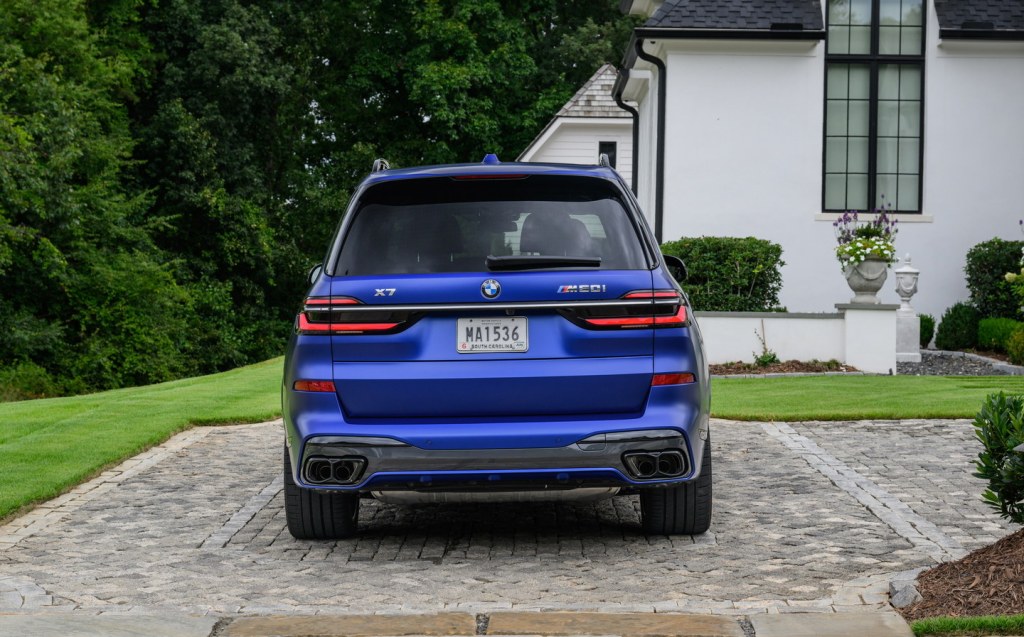
BMW has overhauled the X7 much more than a midlife model facelift usually warrants and, aside from the divisive styling, it is a triumph, building on the foundations of the original with significantly updated technology, more efficient engines and more luxury than ever. It is a shame that more electrification couldn’t have been introduced, but regardless, those that fancy the idea of 7 Series luxury in an SUV shape will certainly approve.
Related articles
- After reading our review of the new BMW X7, you should check out Will Dron’s review of the Aston Martin DBX707
- Like high-performance cars? Take a read of our review of the Ferrari 296 GTB
- Read Driving.co.uk’s review of the McLaren 765LT, which Will Dron reckons probably “has amphetamines licked” when it comes to thrills
Latest articles
- testing schedule 2
- test schedule
- F1 driver Lando Norris commissions bespoke open-top Land Rover Defender
- Citroën C3 and e-C3 2024 review: Petrol or electric, bow down before the new king of value cars
- Best-selling cars 2024: The UK’s most popular models
- Fourth-generation BMW 1 Series shows its new face with all-petrol line-up for the UK
- Cupra Tavascan 2024 review: Funky electric SUV continues Spanish brand’s EV roll
- Divine intervention? Trump-supporters’ motorhome destroyed after rolling into telegraph pole
- Extended test: 2023 Vauxhall Astra Sports Tourer GS PHEV



































